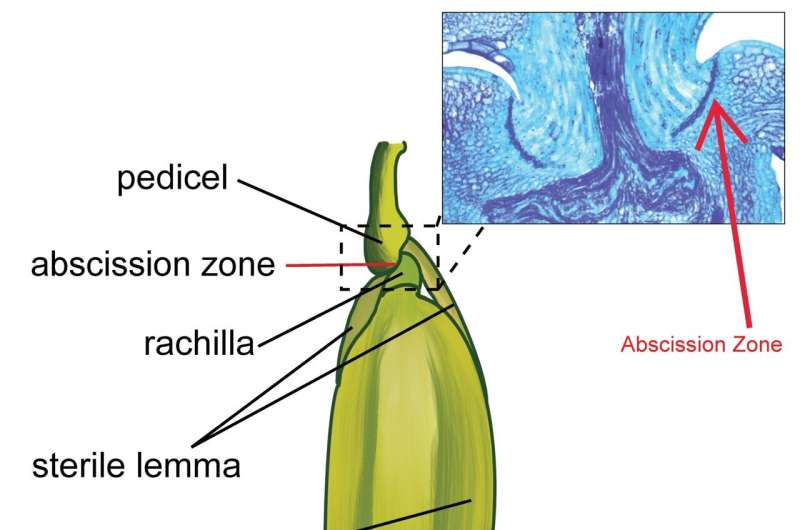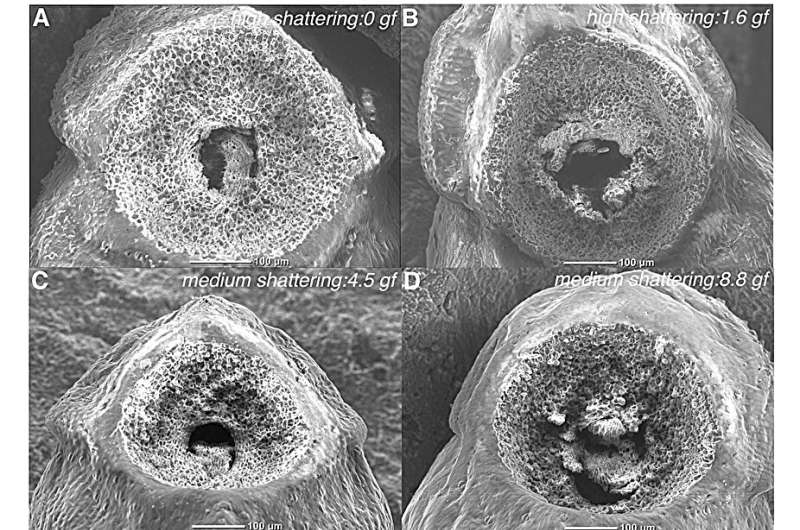
University of Massachusetts Amherst researchers have discovered that the anatomical adaptation helping weedy rice varieties to proliferate is not, as previously believed, confined only to these pest varieties. The research, published recently in the Journal of Experimental Botany, shows that despite 10,000 years of human cultivation, a cell tissue that allows rice plants to easily drop their seeds remains a feature in nearly all cultivated varieties of the grain, though to a lesser degree and with much more variation.
The continued proliferation of weedy rice, a type of rice that is a pest in cultivated fields, suggests that the way we cultivate rice inadvertently also selects for weedy behavior; this is particularly evidenced by the fact that cultivated rice continually de-domesticates into weedy varieties.
“For the past few decades, we biologists have been telling ourselves a story about how rice domestication occurred.” says Ana Caicedo, professor of biology at UMass Amherst and the paper’s senior author. “But when we started looking very closely at a wide array of different rice varieties, it turns out that old story is far too simplistic and obscures what is actually happening.”
The story begins long before humans entered the picture, when the wild ancestor of cultivated rice evolved the ability to “shatter,” or easily drop and disperse its seeds rather than hang on to them.
“Shattering,” or easily dropping seeds, is an evolutionarily elegant reproductive strategy, allowing a plant to spread widely and quickly, and is possible because of the formation of the “abscission zone:” a special kind of tissue located at the base of each rice grain—the part we eat—that connects the grain to the plant.
Enter the humans.
While shattering is beneficial for wild plants, it is a drawback for harvesting grain, because most of the seeds would be lost before they could be gathered by a hungry human. Over many millennia, humans have selected for different cultivated rice varieties, each of which has its own domestication history, that hold on to their grains more tightly than their wild progenitors, and it has long been thought that the abscission zone, and thus shattering, had been bred out of cultivated rice.
However, cultivated rice has also evolved into weedy rice varieties which shatter and are so successful that they are one of the leading factors in limiting cultivated rice production worldwide. In fact, weedy rice is really many different groups that de-domesticated, or evolved independently, from various cultivated varieties.
“The abscission zone has long been recognized as a critical factor influencing shattering in rice, but it has not been thoroughly examined,” says Xiang Li, the paper’s co-lead author who completed this research as part of his graduate studies at UMass Amherst.
“We needed to look at more rice individuals to uncover the pattern of this specialized tissue in different rice varieties. This anatomic investigation will improve our understanding of rice evolution and lay the foundation for further examination of underlying genetics.”

Li, Caicedo and their team, including co-lead author Daniel Lowey, who was an undergraduate at UMass Amherst when he helped drive this research, collected microscopy images of 86 samples from both the five major cultivated rice groups as well as from de-domesticated weedy rice from multiple locations, including the Iberian Peninsula, South Asia, Northeast Asia and the U.S.
What they found is that while one group of cultivated rice, temperate japonica, has almost completely lost its abscission zone, most of the other cultivated groups have maintained theirs to one degree or another. But there were differences among these abscission zones.
“Visually, we could see clear differences between the abscission zones of the rice we examined, but we could not rely on perception alone,” Lowey explains. “To put numbers to our observations, we developed a set of three novel measures to numerically quantify aspects of the abscission zones we were most interested in.”
The team further discovered that the relative length of the abscission zone—not the simple presence or absence of the tissue—was the variable that best predicted which varieties easily shatter and which are more resistant. While the cultivated groups had abscission zones that varied widely in terms of their length, leading to some differences in the degree to which they had lost shattering, each of the weedy varieties, no matter where they were gathered from, converged on a longer zone.
“What this tells us,” Caicedo says, “is that each time weedy rice evolves, it ‘chooses’ a long abscission zone as the best evolutionary reproductive adaptation.” Conversely, each time rice varieties were domesticated, their abscission zones were modified differently to result in different degrees of loss of shattering.
That so many different independently evolved weedy rice groups have converged on the same adaptation—a long abscission zone and ease-of-shattering—despite 10,000 years of human efforts to maintain rice in domesticated, non-shattering form, means that there’s something about the way humans manage cultivated rice fields that inadvertently selects for these two features. It also suggests that the only way to achieve high shattering is through a long abscission zone.
This also means that our understanding of the long history of humans and rice needs updating. In particular, scientists had previously believed that cultivated rice had lost its abscission zone and that the degree of roughness at the base of a rice grain could signal if an abscission zone had been present, and thus if that rice grain had shattered or not.
However, Caicedo says that “you can’t simply look at the surface of a rice grain, either one from today or an archaeological sample dating back thousands of years, and tell whether or not it was cultivated or if it shattered, because almost all of them have some degree of abscission-zone formation.”
Li adds, “An exciting aspect of our research is that it lays the foundation for examination of underlying genetics. We now know we need to figure out the genes that control the length of the abscission zones in different rice groups. Then we’ll be able to understand when and how all of these changes in the abscission zone arose, and how they have shaped the story of rice domestication and de-domestication.”
More information:
Xiang Li et al, Comparative histology of abscission zones reveals the extent of convergence and divergence in seed shattering in weedy and cultivated rice, Journal of Experimental Botany (2024). DOI: 10.1093/jxb/erae221
Citation:
Rice gone wild: How humans have inadvertently selected for ‘weedy’ rice (2024, July 10)
retrieved 10 July 2024
from https://phys.org/news/2024-07-rice-wild-humans-inadvertently-weedy.html
This document is subject to copyright. Apart from any fair dealing for the purpose of private study or research, no
part may be reproduced without the written permission. The content is provided for information purposes only.

